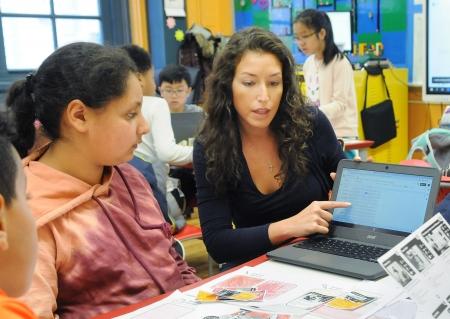
Teacher Erin Schneider works with IS 259 students on their interdisciplinary Mars project.
If you are an educator without any formal training or background in science, being told to teach STEAM (science, technology, engineering, art and mathematics) may seem daunting. There’s the fear of the unknown, the fear of failure, the fear of not being able to tackle it all.
Having taught science and STEAM for about a decade, I’m here to ease your concerns and offer some advice for anyone who wants to take a stab at incorporating STEAM into their curriculum.
Misconception No. 1: You need an engineering background to teach STEAM.
“Engineering” doesn’t necessarily mean that you are calculating the hydraulic flow of contaminants or determining a structure’s stability. Although traditionally involved with machines and structures, an engineer is — at the core — an individual who creates, designs and builds. Your students can “engineer” a new species or “engineer” a solution to population saturation.
Some of my favorite units are cross-curricular, focusing on aspects of life that students might not have previously considered to be related to science. What are the patterns we see in nature, or why have ancient marvels withstood time, or what shapes city landscapes? You’re the content expert; let the content guide you.
Misconception No. 2: STEAM fits neatly into a one-period time slot.
If you do a Google search for STEAM activities, you are likely to find neatly packaged one-period manipulative activities. Over the years, however, I’ve found that the best STEAM activities are not conducted in one sitting. If your schedule permits, set aside two to three days for a project. It’s unrealistic to expect a child (or adult) to research, evaluate, plan, design, construct and retain meaningful content in 45 minutes. Plan for a scaffolded lesson that builds on the previous day’s component, tackling a “new” facet of STEAM each day.
Misconception No. 3: Every lesson must hit on every letter in STEAM.
Is a lesson that incorporates measurements, scale and spacial planning any less “STEAM” than one in which students use a computer to animate an image? Absolutely not! Each STEAM unit is standalone and has its own unique features that contribute to the creative skills we’re trying to hone.
Don’t bite off more than you can chew. Sometimes it just doesn’t make sense to include a particular component — and that’s OK, too!
Misconception No. 4: Every science activity is STEAM.
Yes, science is a main component that drives and inspires STEAM activities. But in a science lesson, we know there is one outcome — science is exact (hence the phrase “exact science”). STEAM, on the other hand, is a subjective approach to solving a problem; it’s designing a solution or approaching a task from multiple paths and getting multiple results — all of which can be correct.
So, what really makes a lesson a “STEAM lesson”? For me, it’s the multifaceted nature of a unit, in which inquiry is melded with innovation. It’s understanding why and how things work, and then, students using that knowledge to make a project their own.
How do you get started?
- Step 1: Identify the ultimate goal of your final project, such as innovation or understanding.
- Step 2: Compose a list of the necessary skills students can obtain through scaffolded components.
- Step 3: Develop the isolated activities that will guide your students through the skills and knowledge base to create their final project.
- Step 4: Let your students soar!
Erin Schneider is a STEAM teacher at IS 259 in Bay Ridge, Brooklyn.